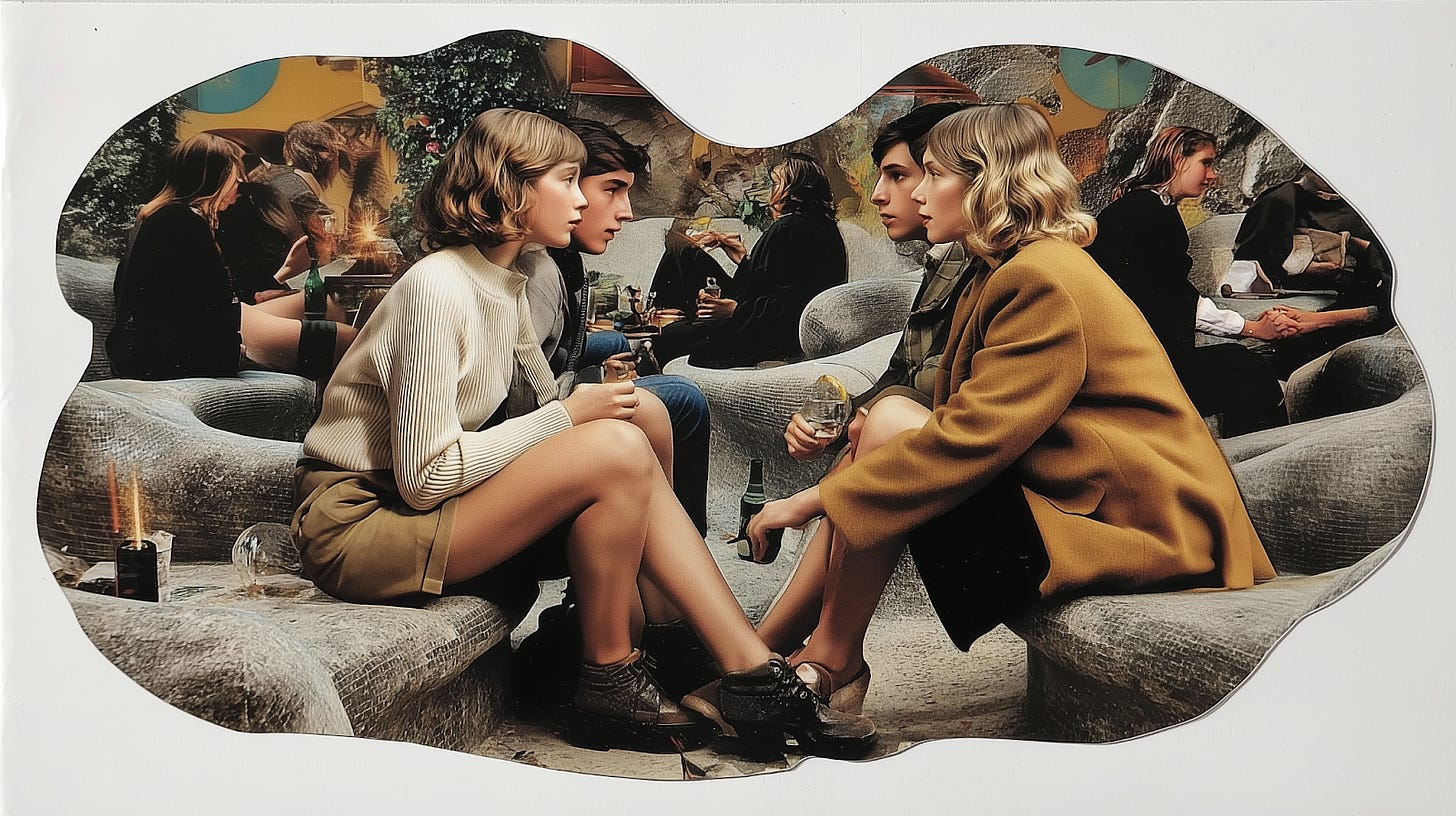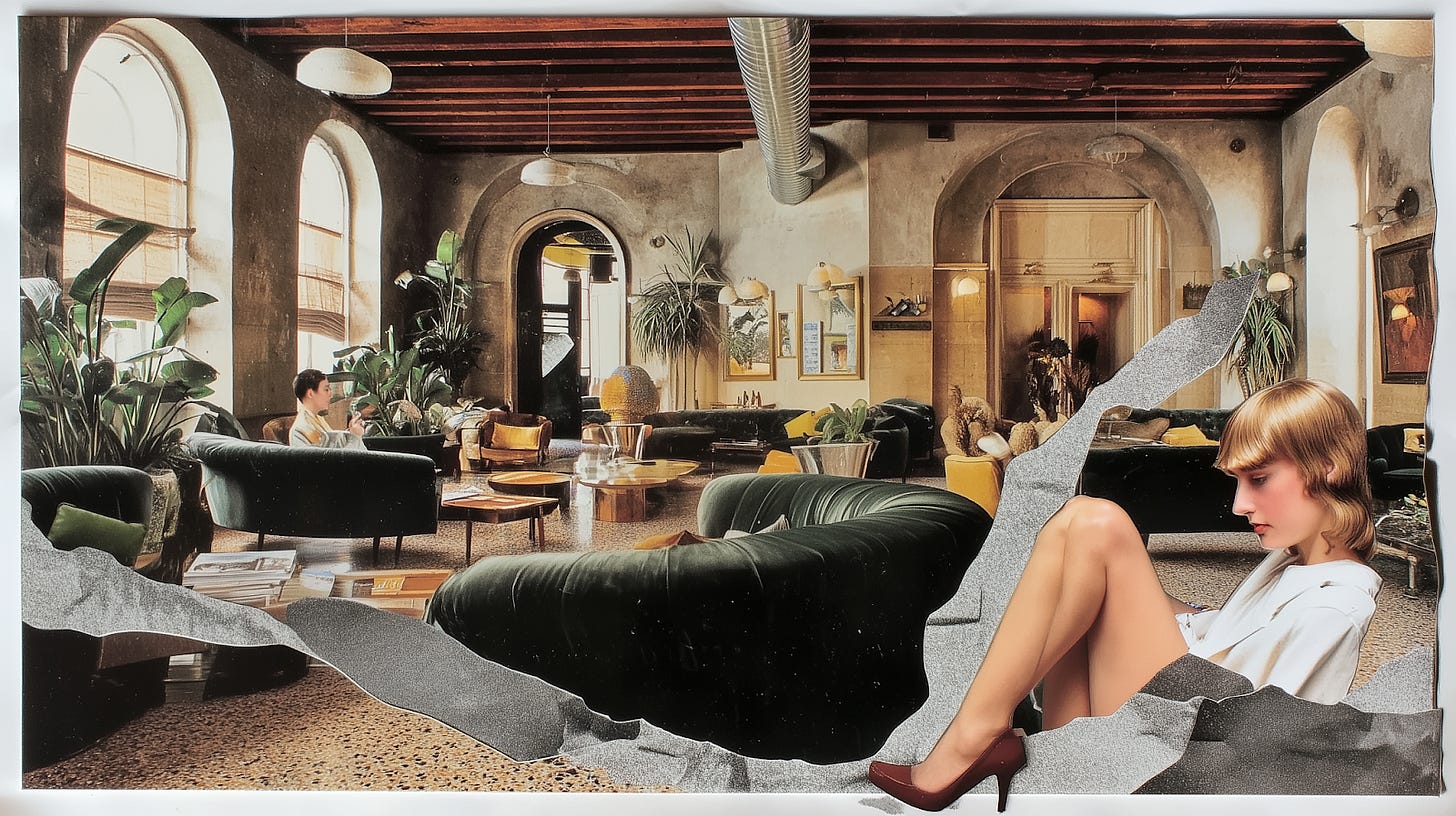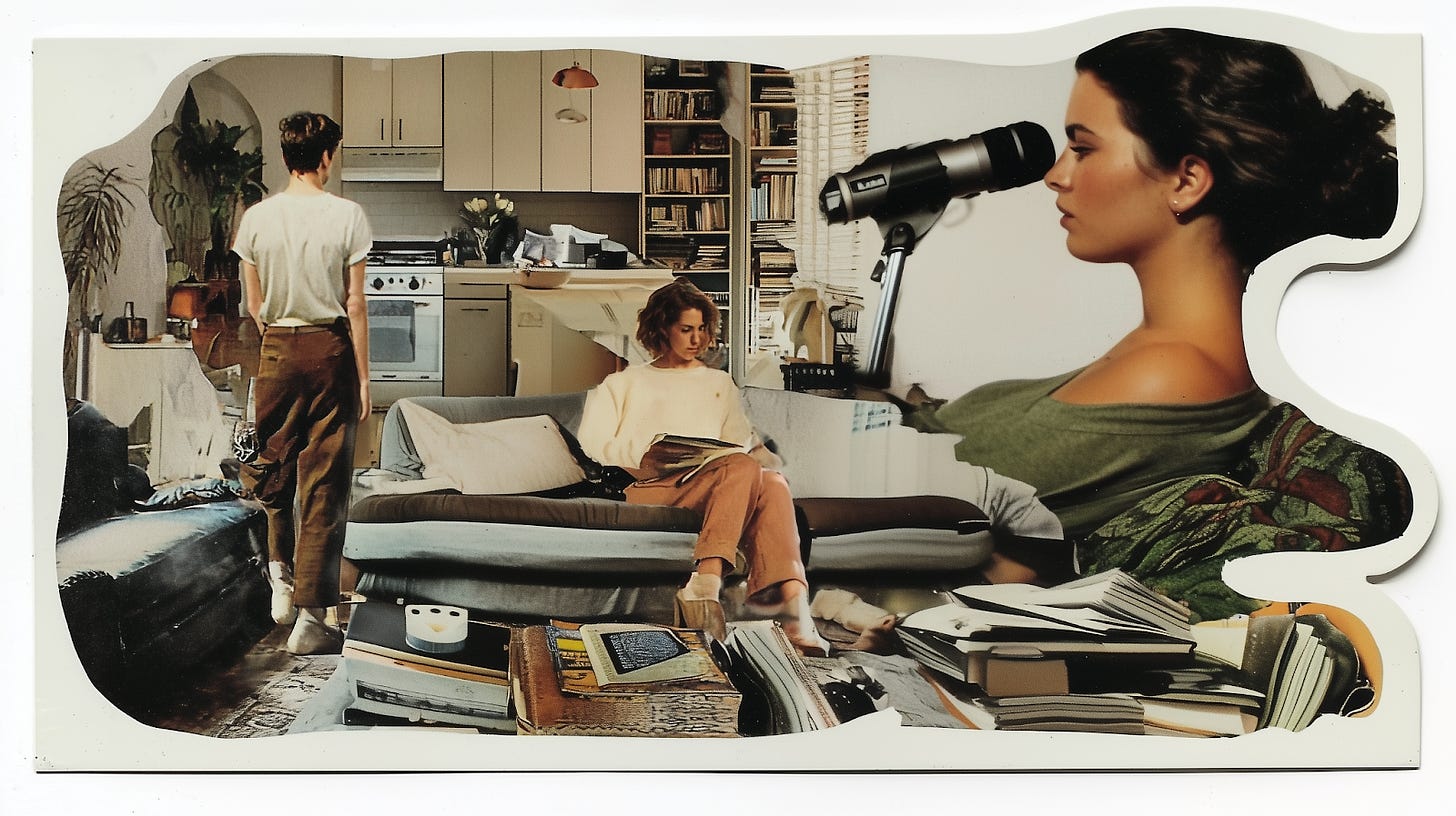Today's Thesis Driven is a guest letter from Jake Rynar and Andrew Johnson of No Walls Studio, which helps developers create branded spaces that people love. They are also authors of the Substack newsletter The NWS.
Trend is a word we love to hate.
We treat "trend" like a dirty word. It feels gimmicky. Temporary. Superficial.
And some trends are: NFT’s lasted as long as a soap bubble, Y2K style is fading back into the sunset, and – appropriate to the built world – flower walls and neons are now as cliché as frosted tips in the 90’s.
But here’s the truth: trends are how culture moves. They reflect who we are, what we value, how we live, and how we want to be seen. Trends are how ideas gain traction, how industries adapt, and how expectations spread.
In real estate, we often wait until a trend is undeniable. By then, it's a cost of entry or even a tired act. Meanwhile, the people we build for are already living tomorrow. Their expectations, tastes, values, and behaviors are evolving faster than most buildings ever will.
And when real estate does try to catch up, it often grabs onto the surface expression—the color palette, the fixture, the amenity wall. But aesthetics are the shallowest part of a trend. They fade first. It’s the deeper shifts—the emotional, behavioral, and systemic drivers—that make a space relevant for more than a season.
This article is about closing that gap. About understanding what a trend really is, how to spot it, and how to use it. Not to chase hype, but to build cultural relevance that sticks.
For this piece, we’re going to dive into:
The building blocks of trends
How to predict trends
Cultural undercurrents of our top trends
The Top 10 trends we see in design
How to leverage these design trends to your advantage
If you're shaping where people live, work, or gather this isn’t nice-to-know, it’s essential. Trend fluency is an advanced form of market intelligence; it helps you direct built projects towards the future, beating all of the yesteryears along the way.
The building blocks of a Trend
Trends are cultural x-rays. They reveal what people are hungry for underneath the surface. A few examples:
We didn’t flood the Clubhouse app in lockdown because the tech was great. We just missed having a community. Substack blew up not because people craved newsletters, but because we wanted trusted voices in a noisy, algorithmic feed. And the open office? That was less about architecture and more about a deep craving to tear down corporate hierarchy.
Every trend, at its core, is a mirror: it shows us what we’re missing, what we’re resisting, or what we’re trying to become.
Some helpful definitions:
Martin Raymond (The Trend Forecaster’s Handbook): “A trend is a new manifestation among people—in behavior, attitude or expectation—of a fundamental human need, want or desire.”
Lidewij Edelkoort (Trend Union): “A trend is the tip of the iceberg. What’s beneath the surface is emotion.”
Henrik Vejlgaard (Anatomy of a Trend): “A trend is a direction of change in values and taste that is observable in a broad group of people over a sustained period of time.”
Ultimately, trends are signals. They represent some deeper human desire; they surface first in niche communities or subcultures, then move through adoption waves until they hit critical mass or burn out.
Short-lived trends—like barn-doors—tend to be novelty-driven. They’re based in aesthetics or social cachet but lack functional, emotional, or systemic staying power.
Durable trends–like biophilia (bringing the outside in)–by contrast, usually stem from macro shifts: climate anxiety (sustainable design), lifestyle blur (mash-up of space types), or collective exhaustion (softer lighting, restorative materials). These are less about “what’s hot” and more about “what’s inevitable.”
As the cultural anthropologist Grant McCracken describes in Culture and Consumption, trends have cultural velocity when they connect both “surface” and “deep structures”—the immediate need and the long-held values beneath. When both align, the trend has staying power.
So forget chasing the next big thing. Start watching the slow shifts underneath.
How to Predict the Future
Want to get ahead? Stop thinking about what’s next. Start thinking about what’s changing.
A trend is a shift in collective desire. Some come and go. Others unfold slowly, reshaping everything in their path. The strongest ones do both: they feel urgent now and inevitable later.
Remote work is a perfect example. It felt like a revolution in 2020, but its seeds were planted long before: cloud tools, burnout culture, flex schedules, and the freelancer economy. The innovators of this trend were digital nomads and solo founders. The early adopters turned it into an aspirational lifestyle (#vanlife). The early majority adopted it under pressure. And the laggards? They’re pretending like the only way to run a business is badging-in 5 days a week.
Real estate tends to build for the late majority. But when you’re following what’s already everywhere, you’re already behind.
Here are few frameworks futurists and trend strategists use to understand what’s emerging:
PESTLE (Political, Economic, Social, Technological, Legal, Environmental)
To a relative degree, these six forces shape every trend – here are some ways this plays out in real estate:
Political ex.) Local elections drive zoning changes, ADU incentives, or short-term rental restrictions. You can’t design for trends without tracking policy.
Economic ex.) Inflation, student debt, and wealth concentration shape what people can afford and how much they’re willing to share.
Social ex.) Loneliness, caregiving, generational dynamics inform household composition, work rhythms, and how people define “community.”
Technological ex.) From virtual staging to smart access to acoustic zoning, tech is reshaping how space performs.
Legal ex.) From short-term rental caps to indoor air quality regulations, compliance is now a design input.
Environmental ex): Fires, floods, and heat waves are spatial problems. Expect indoor-outdoor buffers, durable materials, and location-driven resilience.
Zeitgeist Mapping
This is about tracking the cultural mood – what’s in the air right now.
Are people looking to escape or engage? That emotional climate shows up in spatial design: immersive lobbies, curiosity-driven amenities, deconstructed floorplans. Burnout leads to cozy corners and wellness lounges. Economic anxiety leads to space-as-a-service models. Swagger culture shows up as VIP entrances and backstage moments.
But here’s the catch: Zeitgeist mapping tells you what’s happening today. On its own, it’s reactive. That’s why futurists pair it with other tools—like weak signal tracking—to understand what’s coming next.
Weak Signal Tracking
Spot early, subtle signs of change.
Look where design blogs and Pinterest haven’t reached yet. If three boutique hotels have record players, figure out why. If creative studios are using scent as a design element, explore how olfaction can shape memory in leasing experiences. Weak signal tracking is about horizontal scanning. Look across culture and start playing with ways emerging ideas can show up in your realm.
Emotional Underlayers
Identify the feelings, desires, and tensions driving people’s choices—especially as they evolve in ways that feel fresh, unexpected, or reflective of a broader cultural shift.
Pay attention to the emotions people can’t quite name, particularly when familiar ideas start to show up in new forms. In residential spaces, the instinct to feel protected might surface as additional layers of access control or new private entry vestibules. In offices, the desire to feel acknowledged could translate into a shift towards personalized work zones and fewer hot desks. In hospitality, the craving for comfort might mean more plush seating, softer lighting, or permission to linger.
All of this is pattern recognition. One sighting is novelty. Three is a signal. Five is momentum. Forecasting is spotting the emotional changes before they surface in plain sight.
The Cultural Undercurrent
Before we get to aesthetics, let’s talk about what’s really shifting beneath the surface. These aren’t "interior trends” per say, they’re the cultural mood swings that are defining interior trends.
These are some of the cosmic changes that we’re seeing in people that are – ultimately – showing up in consumer products (especially space).
Screen overload: We’re done with digital all the time. People want physical texture, analog ritual, real presence.
Burnout as a baseline: We’re not “tired.” We’re structurally fried. Recovery has to be baked into how a space moves.
Blurred identity: Your work-self, parent-self, and creative-self all need to share square footage. Space has to flex.
Transference of expectations: If my favorite restaurant nails service, why is my apartment lobby a dead zone?
Friction fatigue: People won’t read your instructions. Intuition wins.
Clarity in chaos: Minimalism isn’t aesthetic. It’s peace.
Distrust in systems: If people don’t trust the institution, they better trust the space.
Need for proof: Don’t say it’s sustainable. Show me.
Some of these are a flash in the pan. Some will rewrite the playbook. Your job is to tell the difference.
That’s where another critical idea creeps in: monoculture. Monoculture is the dominant system of sameness. It’s the trendy lobby with the same chairs, the same art, the same fake ficus. It’s where everyone’s saying “yes” to the same moodboard because it looks safe.
Monoculture copies the expression. Trend captures the need.
The difference? One fades. The other builds relevance. In order to nail a durable trend, you need to keep your eye on the cultural undercurrent without getting distracted by the monoculture.
What follows are ten trends we’re watching. Each one maps to at least one cultural current. Each one can be short lived or durable, depending on how well you use it.
10 Trends We’re Watching (And How to Read Them Right)
1. Soft Geometry
Rounded edges. Sculptural forms. Organic curves that break up the grid. This is spatial design as emotional balm—an answer to a world of hard edges, sharp screens, and constant alerts. We’re seeing this show up in banquettes that feel like hugs, oval-shaped islands that slow you down, and wavy mirrors that add softness to sterile spaces.
But not all curves are created equal. The monoculture version is the blob sofa; visually cute, functionally useless. The breakthrough version? Using geometry to guide flow, soften acoustics, and support the nervous system.
This is a spatial answer to emotional safety. It reflects our social need for softness and our environmental need for calm in the chaos of open plan.
2. Rest-as-Design
Burnout isn’t a trend. It’s the baseline. And design is starting to respond.
Rest-as-design goes beyond cozy vibes. We’re seeing sleep pods in office towers, decompression rooms in high end buildings, and circadian lighting in amenity lounges. Rest is purpose built.
The monoculture version? Dark paint equals = moody = restful. The breakthrough version? Designing rhythms into the space: places to retreat, lighting that shifts with the day, rituals that encourage pause.
The forecast here is clear: in a culture pushing past capacity, spaces that support recovery win.
3. Tactile Reclamation
Screen fatigue has turned us into sensation seekers. Tactile design is the response.
This is a return to honest materials: raw wood, coarse linen, unglazed tile, hand-thrown ceramics. Surfaces that invite touch. Textures that remind us we’re human.
The monoculture version? Faux-natural materials that look the part but feel like plastic. The breakthrough version? Letting materiality lead: walls that breathe, counters you lean into, flooring you want to kick your shoes off on.
It’s texture as therapy, especially in a culture overrun by smooth glass and pixel light.
4. Layered Life
People don’t live single-threaded lives anymore. Your kitchen might be a classroom, your lobby might host a side hustle. Space has to flex with you.
Layered life means designing for multiplicity. Convertible lounges. Zoned rooms. Lobbies that aren’t just transitional, but transformational. It’s hospitality meets productivity meets intimacy.
The monoculture version? A cramped "flex room" with no actual flexibility. The breakthrough version? A resident library that turns into a listening room. A lounge that’s as good for solitude as it is for socializing.
This one’s driven by technological change, economic pressure, and the blur of identity.
5. Sentimental Detail
In a world of mass production, people want something that feels like it came from somewhere.
This trend is all about specificity. Quilted throws that remind you of a grandparent’s home. Archival prints from the neighborhood. Interior moments that carry memory.
The monoculture version? Vintage-look wall art from a catalog. The breakthrough version? Commissioned pieces from local artists. Custom work that reflects the story of a place.
It's a high emotional IQ design. A reaction to placelessness and a move toward meaning.
6. Elevated Infrastructure
We used to hide the guts of a building. Now we’re celebrating them.
Pipes, ducts, and vents can become visual features. This isn’t industrial for industrial’s sake. It’s utility with poetry.
The monoculture version? Painting the ducts black and calling it a day. The breakthrough version? Designing the infrastructure into the rhythm of the space. Making it visible, legible, and beautiful.
This trend is powered by a desire for honesty. It aligns with ESG (environmental, social and governance) transparency and a cultural shift toward showing how things work.
7. Messy Modernism
Perfect is out. Personal is in.
This is the rise of the intentionally unpolished. Spaces where contrast is a feature, not a flaw. Where a 70’s lamp lives next to a Memphis-inspired sculpture and it somehow works.
The monoculture version? TikTok-core color-blocking without narrative. The breakthrough version? Clashing on purpose, with meaning. Every piece in the space has a reason to be there, even if it doesn’t match.
It’s maximalism with memory. Chaos with clarity. A response to the emotional noise of our time.
8. Hospitality Everywhere
The lines between home, work, and leisure are gone. And people now expect a hospitality-grade experience everywhere they go.
This doesn’t mean every space needs to be a hotel. But it does mean layered lighting, great music, and thoughtful service moments. It means thinking like a host, even in an office.
The monoculture version? A coffee machine with branding slapped on it. The breakthrough version? Spaces that make people feel welcomed, cared for, and considered.
This is what happens when expectation transfer meets social instinct. If one space is great, they all better be.
9. Smart Modesty
Tech shouldn’t show off. It should show up.
We’re moving into a phase of design where the smartest tech is invisible. Soundscaping. Predictive lighting. Air quality optimization. Interfaces that respond before you touch them.
The monoculture version? Gimmicky touchscreens no one uses. The breakthrough version? Embedded systems that improve the lived experience without demanding attention.
This is calm technology for a distracted world. Environmental meets emotional.
10. Post-Algorithmic Color
Moodboard fatigue is real. We’re seeing a pushback against palette sameness.
The new color wave is unexpected: muddy blues, soft rust, icy sage, faded lilac. Colors that don’t pop on Instagram but look better at 4pm in real life.
The monoculture version? “This season’s green.” The breakthrough version? Hues that feel like memory, not marketing.
It’s a palette for the emotionally saturated. A shift from showy to subtle. A color story told in whispers, not shouts.
How should real estate developers navigate trends?
Stop reacting. Start listening. The most culturally relevant buildings are designed by teams who know how to observe, synthesize, and lead.
Here’s a playbook:
Follow innovators, not Pinterest. Pay attention to what movers and shakers are doing in big population centers; not just what’s trending visually. Trend pros use the terms homophily to describe people who stick to echo chambers and heterophily to describe people who collect in diverse groups. You’ll see the weak signals of durable trends in the heterophily (so go find them).
Attach to meaning. Design choices should reflect values. What’s the emotional takeaway of this space?
Experiment at the edge. Try small trend-forward concepts at a limited scale before rolling them out.
Use trends as tension. You shouldn’t follow the monoculture. Find opportunities to break free, using the cultural undercurrents as your north star.
Train your team to see. Teach developers, designers, and asset managers how to read culture like strategists.
Most of all, don’t just spot the trend, define it.
You don’t need to chase every design moment. You don’t need to guess the next color of the year. But you do need to know what your audience values. You need to know what the culture is tired of. What it’s leaning toward. And what it’s missing.
The best real estate brands won’t just follow trends. They’ll learn how to translate them. To create spaces that resonate, push back, surprise, and connect.
Because relevance is about showing up with something to say.
—Jake Rynar and Andrew Johnson




















